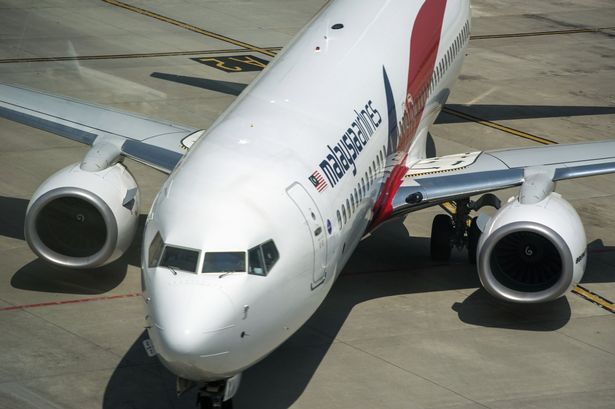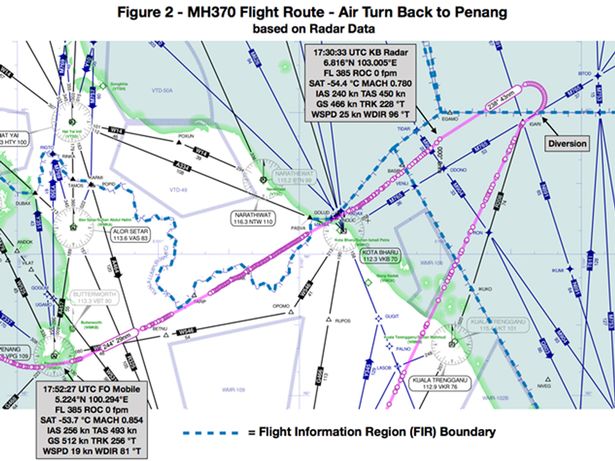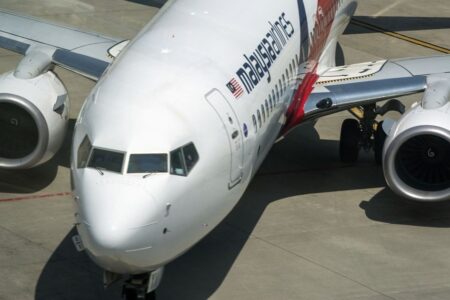The pilot of missing MH370 made a series of ‘deliberate’ turns and route changes before the plane plummeted into the Indian Ocean, an expert claims.
Aerospace engineer Richard Godfrey has been investigating the missing aircraft for years after it mysteriously vanished en route from Kuala Lumpur to Beijing.
The expert reportedly believes ‘depressed’ pilot Zaharie Ahmad Shah purposefully mapped out a path to dodged flight radars on a mission that took the 239 aboard the flight to their deaths.
Based on his own fresh research mapping the plane’s last known positions, Mr Godfrey has come forward with a new theory outlining the missing aircraft’s final moments based on weak flight radar signals.
He believes Zaharie deliberately steered the Boeing 777 into areas where it would go undetected, before taking the craft soaring into dizzying altitudes that would have swiftly incapacitated then killed the passengers and crew, before nosediving the flight into the ocean, The Telegraph reports.
The pilot would have had enough oxygen in the cockpit to continue controlling the plane in the final descent to its watery grave, Mr Godfrey claims.

(Image: AFP/Getty Images)
MH370 had dropped off radar screens after taking off from Kuala Lumpur International Airport and heading on its ill-fate route to Beijing.
Officials investigating its March 2014 disappearance had already established that the plane can be seen taking an unexplained U-turn from its planned flight path, then heading back across the Malay Peninsula and the Malacca Strait before vanishing.
These points have informed the years of searches for the doomed Malaysian Airlines jet, along with confirmed pieces of debris that turned up in the Indian Ocean following its disappearance.
In the years since its disappearance, key pieces of confirmed and suspected MH370 debris have turned up in Mauritius, Madagascar, Tanzania and South Africa, confirming passengers’ and crews’ loved ones’ worst fears.

But despite the most expensive and exhaustive search in the history of aviation, MH370’s wreckage has never been found – and grieving relatives still do not have clear answers on fate of the missing victims seven years after its disappearance.
Now, Mr Godfrey claims to have found a way to trace the plane’s final movements.
He has reportedly mapped out its movements using data from Weak Signal Propagation (WSPR), a global network of radio signals that can track the movement of planes.
He claims to have traced MH370’s movements using WSPR as it crossed signals and set off “electronic trip-wires”.
“WSPR is like a bunch of trip-wires or laser beams, but they work in every direction over the horizon to the other side of the globe,” Mr Godfrey’s report explained.
(Image: AFP)
The aerospace engineer’s research found MH370 crossing eight of the invisible “trip-wires” as it flew over the Indian Ocean.
The findings reportedly fit with official maps of the plane’s last known flight path.
But Mr Godfrey’s research adds to a widely held theory that the flight’s disappearance was deliberate.
His research claims the plane’s change in movements and speed as it deviated from its planned route to China appeared to suggest whoever was steering the craft was trying to avoid leaving clues.
“The flight path appears carefully planned,” he added.
(Image: FAZRY ISMAIL/EPA-EFE/REX/Shutterstock)
“The level of detail in the planning implies a mindset that would want to see this complex plan properly executed through to the end.”
In the years since MH370’s disappearance, key theories have speculated that the pilot was depressed and had deliberately crashed the plane into the Indian Ocean, taking all passengers and crew aboard with him.
In 2016, New York Magazine claimed to have obtained access to a Malaysian Police investigation file that suggested Zaharie had previously used a home-built flight simulation to plan and fly the path he has believed to have taken MH370 on in its final flight.
Friends of the pilot have over the years claimed the married father was lonely and depressed.
(Image: AFP/Getty Images)
Aviation expert William Langewiesche wrote in The Atlantic in 2019 that “there is a strong suspicion among investigators in the aviation and intelligence communities that he was clinically depressed.”
Earlier this year, Peter Foley, who led Australia’s search team for the missing jet called for the search for MH370 to resume based on fresh evidence.
He demanded a new inquiry into the plane’s disappearance, based on new research carried out by oceanographers and flight experts.
(Image: REUTERS)
Their findings suggested the aircraft’s wreckage could be at the bottom of the Indian Ocean in a deep sea area of mountainous trenches and canyons off the coast of western Australia.
The experts believe the wreckage could be in in an area of water 1,200 miles west of Cape Leeuwin where it may have plunged in an uncontrolled high speed dive, The Times reported in March.
The experts analysed ocean drift and a review of a revised flight path to pinpoint the potential crash site.
The Malaysian government has previously said it will only mount another search if compelling new evidence was found, after a massive international hunt estimated to have cost AUD $200million (£111m).

